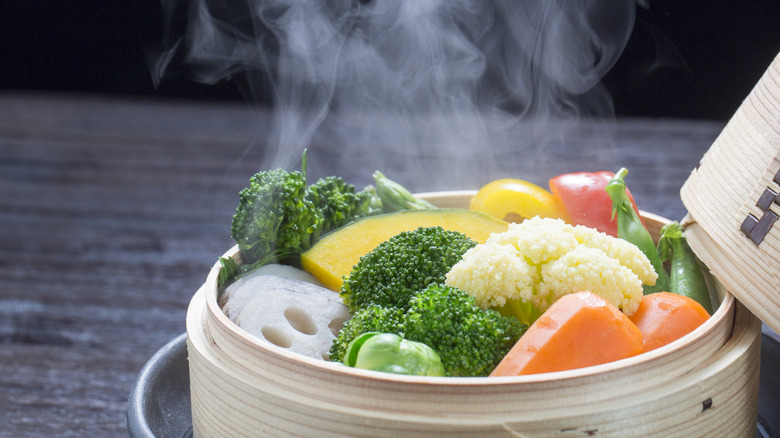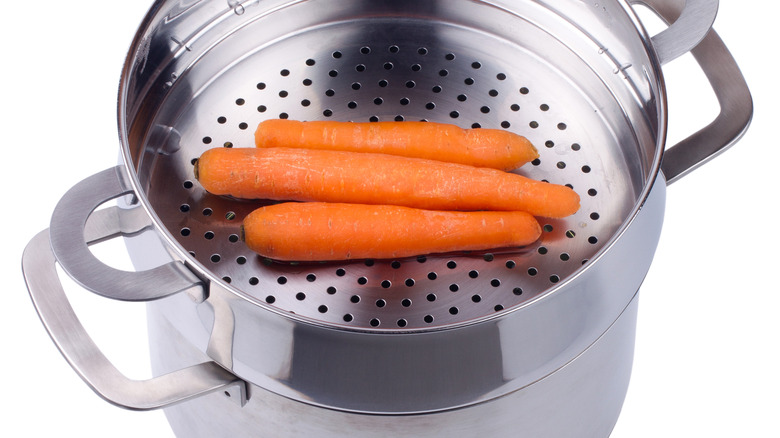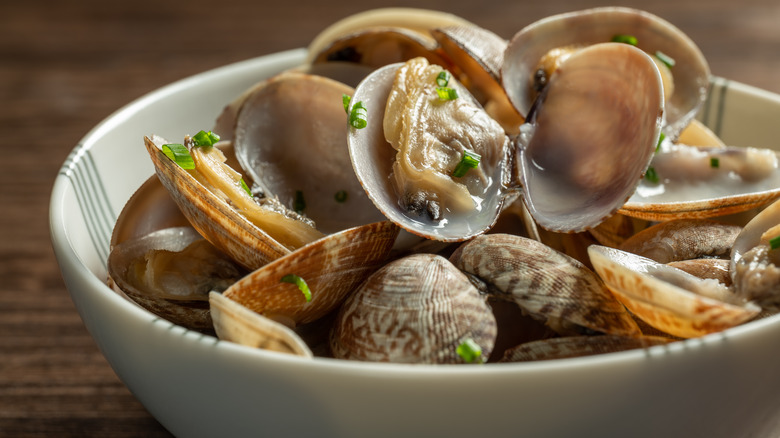Timing Is More Crucial Than You Think When Steaming
We may receive a commission on purchases made from links.
Steaming is a gentle and fast way to cook foods that is very healthy, per Food Network. Unfortunately many people think that steamed foods are not flavorful, or are mushy and overcooked. The fact of the matter is that steamed food is delicious, with tender-crisp texture and enhanced flavoring from the gentle cooking technique. Additionally, Consumer Reports says that steamed foods retain more of their nutrients. The options are near limitless as you can steam veggies, chicken, fish, shellfish, dumplings, or even fruit. While steaming seems simple, there are some rules you have to follow to get the best results.
For the uninformed, steaming uses vapor from simmering water to cook food rapidly. While you can buy a steamer that works with the touch of a button, or a stacked bamboo steamer made just for that purpose, you don't need special equipment, per Masterclass. Simply put, a steamer needs holes in the bottom to let the steam reach the food, so an ordinary double boiler won't work. A metal or heatproof colander that fits over a sturdy saucepan is fine, however.
Once you get everything set up, and have prepared the food you want to cook, the crucial part is timing. You can't just let food cook without watching it, or without setting a timer to the correct number of minutes. Rather, you must time your steamed food carefully.
How to steam food
This may be surprising, but steaming is the fastest way to cook food, according to Harold McGee, via the Washington Post. First, add water to the bottom pan, then bring the water to a simmer, per Culinary Physics. This step is crucial. If you add the food before the water is fully simmering, your timing will be off. Start the timer after the water is simmering and you have added the pan with the food along with a cover.
Make sure that the simmering water isn't not touching the food; that will overcook it. Additionally, be sure that the top pan is covered tightly to hold in the heat. If you don't have a lid, use heavy duty foil and crimp it carefully to the sides of the pan. Finally, follow the recipe carefully for best results. BBC Good Food has a chart about how long veggies should steam, and Hama Hama will tell you how to steam clams, while Food Network has advice about steaming shrimp.
As for flavoring the food, you can add herbs and spices directly to the meat or veggies, or you can add flavorful ingredients to the simmering water, per The Seattle Times. While this method is subtle, the hints of herbs or cinnamon are delicious. You can even use beer, wine, or broth instead of water in the bottom pan, per Consumer Reports, to add even more flavor.
Enjoy perfectly cooked steamed food
It's important that you take precautions to be very careful when working with steam, since it is very hot. Steam can cause burns in seconds, so use hot pads or oven mitts and don't let your skin come into contact with the steam. Now that you're a steaming expert, it's time to try some recipes.
You can steam any vegetable you'd like, using the charts provided above. Make sake steamed salmon for your next dinner party, and serve it with steamed asparagus or broccoli. Sake and the marinade is added to the steaming water for fabulous flavor. For a special dinner, make steamed crab legs, cooked to tender perfection, and add some melted garlic butter on the side. Ginger soy steamed fish is another wonderful recipe, flavored with soy sauce, oyster sauce, and toasted sesame oil. Soba noodles with steamed vegetables is a delicious and simple recipe for a weeknight, tossed in a fragrant sauce of cilantro, ginger, and lime. Finally, sake steamed clams are a wonderful appetizer or light main course.


